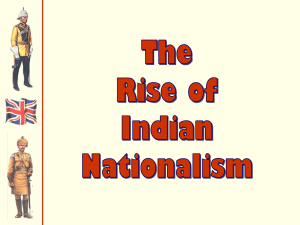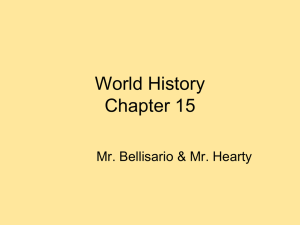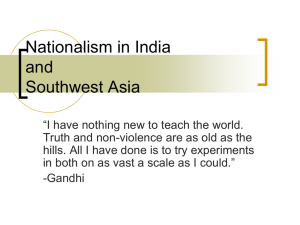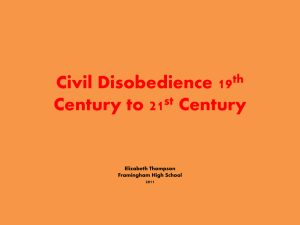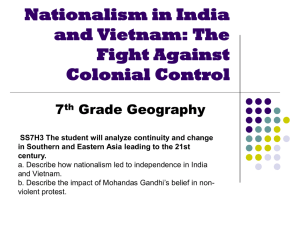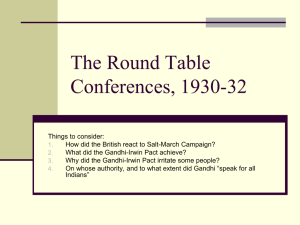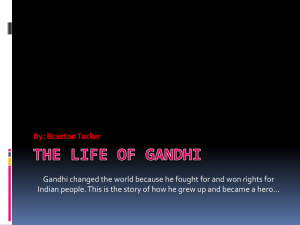Indian Nationalism
advertisement
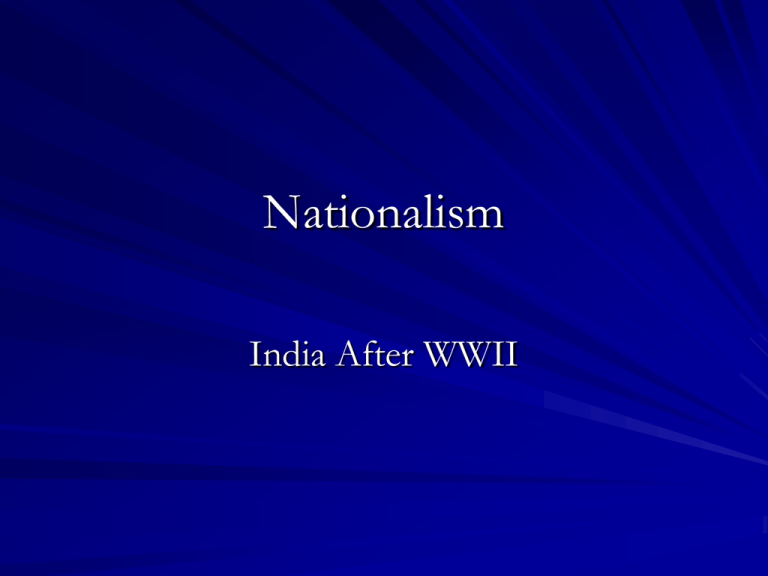
Nationalism India After WWII Self-Determination Means to allow people, nations, countries to decide what government they want and how they want to be ruled. This was a challenge to the colonial system. Countries like Britain did not want self determination after World War One because it meant that they would have to give up rule in places like India. World War One During World War One about 1 million Indians fought for Britain. Britain had promised India self rule after the war however Britain failed to keep their promise. Indian Nationalism India had wanted independence since the mid-1800’s. Indians wanted both democracy and nationalism. Well educated Indians began to bring back these ideas from Europe. National Movements Indian National Congress 1885 – A Hindu group wanted Hindu representation in government. – Well educated – Wanted a democratic India Muslim League 1906 – Muslim educated class wanted representation in government – Based their ideas of democracy on the ideals of the Enlightenment. While both groups were very different and disliked each other they both wanted a democratic representative government. Rowlatt Act In 1918 Indian soldiers and the the Indian public wanted Britain to uphold it’s promise of self-determination. Indians began to protest. In 1919 to stop protesting the British passed the Rowlatt Act which allowed them to jail protestors for up to two years with no trial! – To educated Indians this was a violation of Denial of trial by a jury. The Amritsar Massacre In 1919 Indians began a system of violent protest to the British rule. Hindus and Muslims went to Amritsar to protest the Rowlett Act. Amritsar Massacre At the festival at Amritsar Indians gathered to celebrate and make speeches. The event was non-violent. Hindu and Muslim nationalist began to arrive at the festival. British citizens were attacked. The British banned public meetings. Amritsar Massacre On April 13, 1919 to British believed that the Indians were defying to order not to meet in public. British soldiers were ordered out to stop the people. The soldiers are ordered to open fire on the crowd. Indian Nationalism 400 Indians are killed. 1,200 are wounded. Indians across India are outraged. Indians demanded impendence from Britain. Indian Nationalism "The nonviolent approach does not immediately change the heart of the oppressor. It first does something to the hearts and souls of those committed to it. It gives them self respect; it calls up resources of strength and courage that they did not think they had. Finally, it reaches the opponent and so stirs his conscience that reconciliation becomes a reality." (Martin Luther King) Civil Disobedience One person can make a difference. Civil Disobedience – Civil Disobedience Refusing to obey laws or the government without using violence and in some cases enduring violence directed towards you. Civil Disobedience Civil disobedience has served as a major tactic of nationalist movements in former colonies in Africa and Asia prior to their gaining independence. Most notably Mohandas Gandhi developed civil disobedience as an anti-Imperialism tool. Martin Luther King, a leader of the US civil rights movement in the United States in the 1960s also adopted civil disobedience techniques Antiwar activists both during and after the Vietnam War have done likewise. More recently, people have used civil disobedience to protest the war in Iraq Civil Disobedience There is a rich tradition of nonviolent direct action in the United States as well. American revolutionaries used tactics such as tax and tea boycotts to mobilize thousand of colonists against the British. American peace churches have a long tradition of noncooperation with military conscription and taxation. Beginning in the late 1800s, the women's movement for the right to vote carried on a century of silent vigils, mass demonstrations, and hunger strikes. Civil Disobedience In his book The Politics of Nonviolent Action, Gene Sharp has categorized 198 methods of nonviolent action, which can be broken down into three main types Civil Disobedience Protest and persuasions – leaflets, pickets, vigils, teach-ins, marches. Civil Disobedience Non-cooperation: – social boycotts, student strikes, – economic labor strikes, tax resistance, consumer boycotts – political election boycotts, civil disobedience, draft resistance Civil Disobedience Intervention – sit-ins, occupations, alternative economic and social institutions, obstruction, work slowdowns and sabotage. Forms of Protest Protest expresses relatively overt reaction to events or situations: sometimes in favor, more often opposed. Protestors may organize a protest as a way of publicly and forcefully making their opinions heard in an attempt to influence public opinion or government policy, or may undertake direct action to attempt to directly enact desired changes themselves Forms of Protest Violence – – – – Riots Terrorism Revolts Revolutions With violence comes death and destruction of property. The cause though a just cause may be confused by the public as being violent and may lose public support. Violence does not solve problems. Forms of Protest Non Violent – Boycotts Refusing to buy or trade goods. – Sit-ins Sitting down and refusing to leave an area. – Hunger Strikes Refusing to eat. – Peaceful Protest Marches Showing mass public support for the cause. – Petitions Letter writing campaigns and getting signatures to show mass support for the cause. – Strikes Refusal to work. Indian Civil Disobedience Satyagraha (Sanskrit truth + path/way) is the philosophy of non-violent resistance most famously employed by Mohandas Gandhi in forcing an end to the British Raj. Translators have rendered the word satyagraha as "civil disobedience", "passive resistance", "truth force", or "the willingness to endure great personal suffering in order to do what's right". English-speakers may also use the term "non-violent protest". Gandhi He helped bring about India's independence from British rule, inspiring other colonial peoples to work for their own independence and ultimately dismantle the British Empire and replace it with the Commonwealth. Gandhi's principle of satyagraha, often roughly translated as "way of truth" or "pursuit of truth", has inspired generations of democratic and anti-racist activists including Martin Luther King, Jr. and Nelson Mandela. He often stated his values were simple: truth (satya), and non-violence (ahimsa). Gandhi’s rules for Protest Mohandas Gandhi outlined the following rules: A satyagrahi, i.e., a civil resister, will harbor no anger. He will suffer the anger of the opponent. In so doing he will put up with assaults from the opponent, never retaliate; but he will not submit, out of fear of punishment or the like, to any order given in anger. When any person in authority seeks to arrest a civil resister, he will voluntarily submit to the arrest, and he will not resist Non-retaliation includes swearing and cursing. Therefore a civil resister will never insult his opponent, and therefore also not take part in many of the newly coined cries which are contrary to the spirit of ahimsa. Gandhi Gandhi An eye for eye only ends up making the whole world blind Poverty is the worst form of violence. Strength does not come from physical capacity. It comes from an indomitable will. Hatred can be overcome only by love Martin Luther King Jr. MLK We will have to repent in this generation not merely for the hateful words and actions of the bad people but for the appalling silence of the good people. Take a few minutes and write down what this means-What is King saying? Gandhi Indian Independence Civil Disobedience Early Life Mohandas Gandhi was born on October 2, 1869, in Porbandar, Gujarat, India. His family was traders. At the age of 13, Gandhi married Kasturba who was of his same age. They had four children, all sons. At the age of 19, Gandhi went to London to train as a lawyer. He went to Durban , South Africa to practice law in 1893 and began his political career by lobbying against laws discriminating against Indians in South Africa. Gandhi was arrested on November 6, 1913 while leading a march of Indian miners in South Africa. Early Life During World War I, Gandhi returned to India, where he campaigned for Indians to join the British Indian Army. Gandhi actively supported the British in World War I in the hope of hastening India's freedom. He also led agrarian and labor reform demonstrations that embarrassed the British. Gandhi The Amritsar massacre of 1919 stirred Indian nationalist consciousness, and Gandhi organized several satyagraha campaigns. He discontinued them when, against his wishes, violent disorder ensued Political Career After the war, he became involved with the Indian National Congress and the movement for independence. He gained worldwide publicity through his policy of civil disobedience and the use of fasting as a form of protest, and was repeatedly imprisoned by the British authorities. Civil Disobedience In the 1920’s Gandhi began his system of civil disobedience. Gandhi wanted to weaken the control of the British government over the Indian people. Gandhi called for the following measures. Civil Disobedience Called for Indians to boycott British goods. Gandhi called for Indians to make their own clothing. Gandhi spent one hour a day at the spinning wheel making his own thread. The spinning wheel becomes the symbol of Indian Nationalism. Civil Disobedience The clothing boycott was a success. Indians burned their British clothing and made their own clothing. The sale of British clothing dropped and hurt the British economy Civil Disobedience Gandhi asked Indians to – Boycott British schools. – Not hold positions in the British government in India. – Refuse to pay British taxes. – Not vote in elections. Salt Marches One of his most striking actions was the Salt March that started on March 12, 1930 and ended on April 5, when he led thousands of people to the sea to collect their own salt rather than pay the salt tax. On May 8, 1933 Gandhi began a fast that would last 21 days to protest British oppression in India. Salt Marches Gandhi had shown the people that they could survive without the British. That the people could make their own salt, clothing, and run their own government. Gandhi showed the people the way. Indian Act of 1935 Under the success of the various civil disobedience tactics used by Gandhi the British government began to give into the demands of the Indians. In 1935 under the Indian Act of 1935 Indians were allowed local self-government. Some democratic elections were held. Indians in Conflict The Muslims and Hindu come into conflict during these elections. Both want independence but both want control of the government. The Hindu National Congress which outnumbers the Muslim League wins and controls the government. This causes more problems between Hindus and Muslims. Gandhi His program included a free, united India The revival of cottage industries, especially of spinning and the production of hand-woven cloth. the abolition of untouchables. Gandhi Gandhi became known as a Mahatma or “Great Soul” of the Indian Independence movement. Gandhi Gandhi became even more vocal in his demand for independence during World War II, drafting a resolution calling for the British to “Quit India”, which soon sparked the largest movement for Indian independence ever, Violence in India With India feeling independence so close many Hindus and Muslims took up violence to protest British rule. With mass arrests and violence on an unprecedented scale. This went against the teachings of Gandhi. Indian Independence In August 1946 Britain gave India its independence. Britain gave India to the Hindus and newly formed Pakistan to the Muslims. Soon both the Hindu and the Muslims while free of British rule now turned their violence towards one another. Gandhi Gandhi had great influence among the Hindu and Muslim communities of India. It is said that he ended communal riots through his mere presence. Gandhi was opposed to any plan which partitioned India into two separate countries The plan was eventually adopted, creating a Hindu-dominated India, and a Muslim-dominated Pakistan. On the day of the power transfer, Gandhi did not celebrate independence with the rest of India, but mourned partition alone in Calcutta instead. Gandhi On Jan. 30, 1948, while holding a prayer and pacification meeting at New Delhi, he was fatally shot by a Hindu fanatic who was angered by Gandhi's support for the Muslims. Gandhi was dead, India was free and now Muslims and Hindus were killing one another. Gandhi View clips from the movie Gandhi – Salt Marches Indian Independence A New India Indian Independence In 1947 Britain decided it could no longer rule India. India was granted it’s independence. Jawaharlal Nehru Nehru becomes India’s first Prime Minister. Nehru rules from 1947 to 1964. Nehru hopes for a new future for India. Wants – Industrialization – Rights for women – Elevate the lower caste Indira Gandhi Nehru’s daughter Indira Gandhi is Prime Minster from 1966 to 1984. Under Gandhi India increases her production of grain. Gandhi was assassinated by her Sikh bodyguards after a Sikh revolt. Rajiv Gandhi Indira’s son. His party was accused of corruption. Assassinated in 1991. Democratic India India is the world’s largest democracy. India has a federal system of government. – A strong central gov’t and then smaller local gov’t. Cold War India Cold War – During the Cold War India followed a policy of nonalignment – This policy allowed India to receive aid from both capitalist and communist countries. Muslim v. Hindu Muslim – Were the minority – Muslim League wanted a Muslim state. – In 1947 the British divide India and create a Muslim Pakistan Hindu – Were the majority – The National Congress wanted a Hindu state. – In 1947 the Hindu’s were given India by the British. Muslim v. Hindu The division did not solve the problem. Muslim’s migrated to Pakistan while Hindu’s migrated to India. During the migration millions were killed. Both India and Pakistan would clash over the boarders to their countries. Muslim v. Hindu Because of both religious difference and boarder disputes over Kashmir both India and Pakistan have hostile intentions even today. Both countries also possess nuclear weapons, which poses a threat to each country and the world. Social Problems in India Industrial Growth Social Equality Food Production High cost of equipment The caste system Lack of oil No education for women Rapid population growth Trying to be socialist Floods and drought Religious problems Changes in India – In 1950 India banned discrimination against untouchables. – Untouchables must be allowed to apply for jobs and go to universities. – Women were given the right to vote. – Women were given the right to divorce and inherit property. Discrimination does still exist against untouchables and women. The caste system does still exist. Discrimination exist in rural areas. Sikh Separatism Sikhism is a religion that started in the 1500’s and is a combination of Islam and Hinduism. In the 1980’s Sikhs demanded self-rule and took over the temple at Amritsar. During the revolt Indira Gandhi sent in troops and many Sikhs were killed. Today there are still tensions between Sikhs and Hindus.
